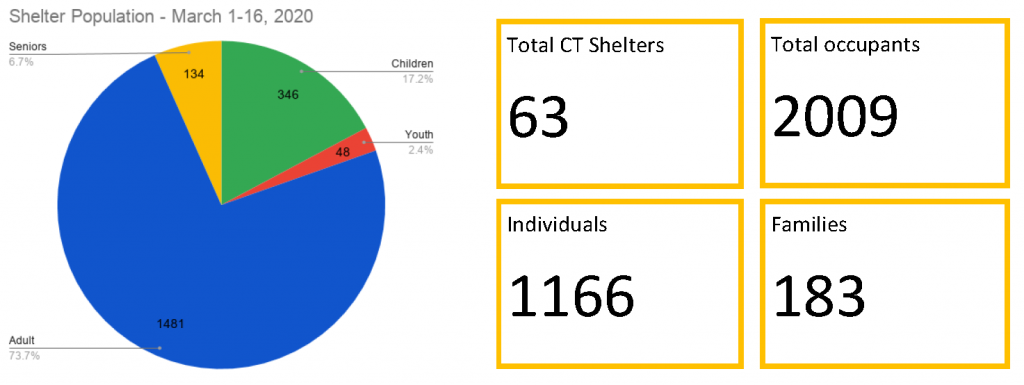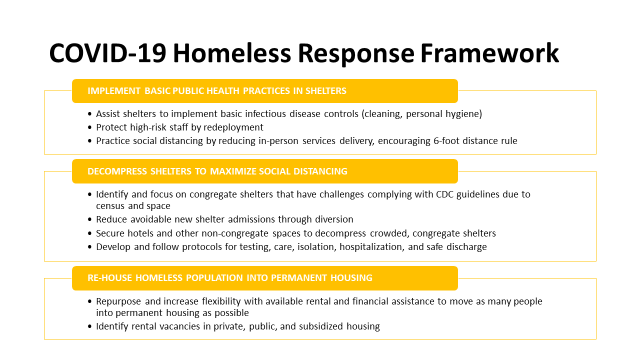Connecticut’s COVID-19 Homeless Response
On March 14, Governor Lamont instructed Connecticut residents to “stay safe, stay home.” This presented unique challenges for people who do not have a place to call home. Read on for a summary of our state’s strategy for supporting clients and shelter staff in staying safe during the crisis.
How You Can Help
COVID-19 Homeless Service Resource Guide
When Governor Lamont first told Connecticut to “Stay safe, stay home,” we immediately recognized the problem for the population we serve. Without homes, our clients would have difficulty keeping themselves safe. Moreover, clients heading out to the street could potentially further spread the dangerous coronavirus to others. In short, we were looking at a potential public health crisis of significant proportions.
First steps: A Look at the Data
CCEH took stock of the numbers. At the time, there were 2009 clients in shelter. Of these, 134 were over the age of 62 and were therefore especially vulnerable (COVID is particularly dangerous for seniors).
Under the auspices of the state’s Emergency Support Function 6 (ESF 6), CCEH worked with the Coordinated Access Networks (link) to analyze the specific layouts of the state’s 63 shelters to determine what steps we would need to take as a coalition to allow staff and clients to safe their social distance from one another.
Keeping Clients Safe through “shelter decompression”
As part of the state’s emergency response to the COVID-19 pandemic, Governor Ned Lamont authorized a large-scale effort to homeless shelter decompression effort in order to prevent outbreaks and community spread of COVID-19 among residents and staff in congregate homeless shelters. Through this effort, homeless shelters determined unable to comply with the Center for Disease Control and Prevention-recommended social distancing and bed spacing guidelines have relocated residents and staff into hotels and motels contracted by the state. This shelter decompression effort in currently authorized through the end of April, though may be extended as needed by the state’s emergency response system.
Why was shelter decompression needed?
Homeless shelters and the people who use them are highly vulnerable to infectious disease outbreaks and pandemics, including COVID-19. Within most homeless shelters, people sleep in dorm- or bunk-style (congregate) arrangements often spaced inches apart, and use shared bathrooms and common dining and living spaces. For this reason, infectious diseases that enter shelters often spread widely and quickly among residents and staff alike. When homeless people become infected, they often have greater challenges due to their underlying health conditions and poor health status and lack of consistent access to health care. Since many shelters are closed during the day, infected shelter residents have the potential for spreading infection further among the general public. Recognizing the potential risk that congregate homeless shelters pose in the COVID-19 pandemic, the CDC issued guidance to homeless shelters, calling on them to implement a number of infectious disease prevention measures, including increasing cleaning and disinfection and ensuring adequate spacing of a minimum of 3 feet and ideally 6 feet between beds. Such bed spacing was found to be difficult to impossible in many of Connecticut’s 63 homeless shelters.
What is our strategy for keeping clients and staff safe?
CCEH, the Department of Housing, and regional Coordinated Access Networks began to implement a series of measures to achieve this social distancing, including reducing new shelter admissions, increasing the pace of exits to permanent housing, and decompression shelters through relocation into hotels.
Who is coordinating this effort?
This effort is being coordinated as part of the State Emergency Operations Center, specifically by the Emergency Support Functions (ESF) 6 Mass Care Working Group, chaired by the Department of Social Services Commissioner Deidre Gifford. ESF 6 charged CCEH and the Department of Housing to co-lead a Homeless Shelter Taskforce to coordinate the shelter decompression effort. Multiple state agencies and key non-governmental entities are assisting in various aspects of this effort. On March 10, Governor Lamont’s Executive Order 7P established the “Authorization to Provide for Non-Congregant Housing for Persons at Risk”, which tasked the state with providing protection of public health and safety during the pandemic by providing alternative, non-congregate shelter and housing for people experiencing homelessness.
How many shelter residents are being relocated?
This effort will relocate 1,263 people in shelter into 13 hotels across the state. We continue to work to keep staff and clients safe by seeking out PPE, staff for vacancies, and volunteers to support their efforts. Here is a snapshot of shelter residents who have been relocated as of April 12, 2020:
What is the process for securing a shelter or hotel bed?
Our state has established 211 as a front door for all the shelters in the state. This includes the hotels, which are currently operating as part of the shelter system. Clients in need of shelter should call the United Way’s 211 hotline. Operators will seek to support clients in finding alternatives to shelter over the phone. Clients who need additional support will be scheduled for assessments to further explore alternatives to shelter. Here is a map of the system flowchart:
What services are being provided to relocated residents?
Staff of non-profit shelter provider organizations staff, with support from regional Coordinated Access Networks, are working to provide services to residents in the hotels. Services include residential aides, case management and services coordination, three meals per day, crisis intervention, provision of basic needs.
What happens if a relocated resident is found to be COVID-19 positive?
The primary focus of shelter decompression is to move people who are not COVID-19 positive into hotels in order to prevent the spread of COVID-19 among homeless persons. However, it is anticipated that some persons relocated to hotels may found to be infected and develop symptoms. When this happens…
What’s next?
Once our coalition has mobilized the full 1,000+ clients into hotels, our next step will be to rapidly exit clients from the shelter system by assisting them in securing permanent housing. To do this, CCEH and the state are able to access rapid exit funds for emergency flexible assistance. CCEH is also partnering with CT Association of REALTORS® and Connecticut Coalition of Property Owners, and other associations of landlords to identify units for our current 2,009 clients.
How can you help?
For more information, please contact Madeline Ravich at mravich@cceh.org
COVID-19 Homeless Service Resource Guide
Connecticut Resources | National Resources | Client Resources | Youth Resources | Food Resources
Summary of Connecticut Resources
- Department of Housing Guidance:
- Memorandum – Emergency Shelter Contractual Requirements During COVID-19 – 04.08.20
- Memorandum – Rapid Re-Housing Apartment Search & Inspection Request Protocols – 03.24.20
- Memorandum – Rapid Re-Housing Prioritization & Paperwork Requirements during State’s Declaration of Public Health & Civil Preparedness Emergency – 03.17.20
- Memorandum – Changes to CAN Appointments for COVID-19 – 03.13.20
- Memorandum – Preparing Shelters for COVID-19 – 03.12.20
- DOH COVID-19 Homeless Response Assessment
- CCEH Guidance:
- CCM Guidance:
- CCM COVID-19 Webinar Recording – 04.06.20
- CCM COVID-19 Municipal Slides – 04.06.20
- Toolkits and Model Documents:
- Resources for Shelter Operations in Hotel Space – 04.07.20
- Sample Preparation Plans from Shelter and Services Providers:
- Sample Notices of Reduced or Modified Services:
- State of Connecticut General COVID-19 Guidance
If you have specific questions regarding DOH policy or protocol, please contact: Leigh Shields-Church or Kara Capobianco
For general questions, please contact: info@cceh.org
Summary of National Resources
- HUD Guidance:
- CDC Guidance:
- NAEH Guidance:
- USICH Guidance:
- CSH Guidance:
- NHCHC Shelter Assessment:
- Guidance for Eligible Cost on Infections Disease Preparedness:
Additional Resources for Working with Clients
- SAMHSA Guidance:
- DCF Guidance:
- Posters and Flyers to Display
- Turning Point CT Guidance:
Resources for Working with Youth
- RHY Provider Guidance:
- Point Source Youth:
- Away Home America:
- NN4Y Guidance:
Food Security Resources:
- Department of Education
- CT Food Bank
- Foodshare




